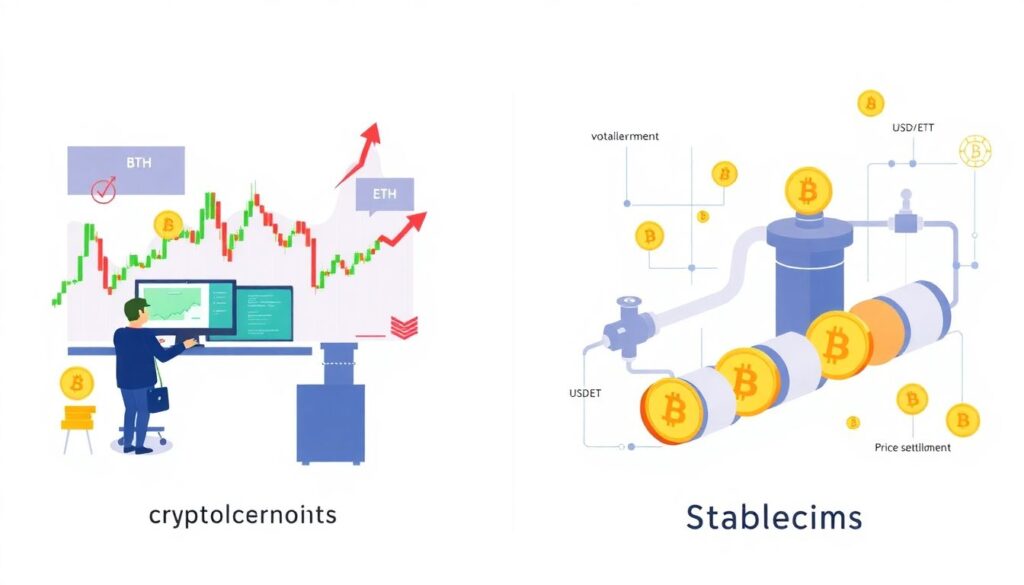Stablecoins sound deceptively simple: “crypto that doesn’t swing like crazy.” But once you look under the hood, you’ll see a whole universe of design choices, risks and opportunities. This guide to stablecoins: mechanics is meant to help you understand not only the tech, but how to actually use these assets strategically — without treating them like magic internet dollars. Over the last three years, stablecoins have grown from a niche tool for traders into core infrastructure for payments, savings and DeFi, and you can either watch that shift from the sidelines or learn to ride it.
Why Stablecoins Matter Right Now
Рeal‑world scale in just three years
From 2022 to the end of 2024, the total stablecoin market cap moved from roughly $160–180B at its peak, down to about $125B after the TerraUSD collapse, and then gradually climbed back to around $150–170B by late 2024. In the same period, stablecoins regularly accounted for 60–75% of all crypto trading volume, with daily turnover often topping $60–80B on volatile days. That means most people touching crypto are effectively touching stablecoins first. Understanding how do stablecoins work today is less about speculation and more about how money moves across chains, exchanges and borders in near real time.
Stablecoin Mechanics Explained Simply
Fiat‑backed: the “cash in the vault” model
When you hear “stablecoin mechanics explained,” the easiest starting point is fiat‑backed coins like USDT or USDC. For every token, the issuer claims to hold one unit of real‑world assets—cash, Treasury bills, bank deposits—so the price stays close to $1. After the transparency scandals of 2021–2022, reporting improved: by 2024, major issuers were publishing monthly attestation reports, showing tens of billions in short‑term US Treasuries as backing. This low‑risk collateral helped them survive the 2022–2023 rate hikes while still keeping redemptions running even during market stress, which rebuilt a lot of lost trust.
Crypto‑collateral and algorithmic hybrids

Crypto‑collateralized stablecoins like DAI work differently: users lock volatile assets (ETH, liquid staking tokens, tokenized Treasuries) into smart contracts and mint a smaller amount of stablecoins against them. Over‑collateralization—the idea that $150 of crypto backs $100 of DAI—creates a safety margin. After Terra’s failure in 2022 wiped out over $40B in market value within weeks, the community became far more skeptical of “pure” algorithmic designs. As a result, by 2024, most surviving projects relied either on strong collateral or on hybrid models with circuit breakers, hard collateral floors and on‑chain risk parameters that can be tightened during stress events.
Practical View: Stablecoin vs Cryptocurrency Differences
Not all digital assets behave the same

One of the most common confusions is stablecoin vs cryptocurrency differences. A typical crypto asset like BTC or ETH is an investment: you expect the price to move, and volatility is the point. Stablecoins, in contrast, are financial plumbing. They’re optimized for price stability, fast settlement and interoperability, not for moonshots. That’s why, between 2022 and 2024, their market cap was far more stable than the broader crypto market, which swung by more than 60% from peak to trough. If you’re planning, say, to pay freelancers abroad, post DeFi collateral or park profits between trades, you want predictability; that’s where stablecoins fit in your toolbox.
Inspiring Use Cases and Success Stories
From traders’ toy to lifeline for real people

If you’re wondering what are stablecoins guide narratives in the real world, look at emerging markets. Between 2022 and 2024, on‑chain analytics consistently showed rising stablecoin inflows to regions battling high inflation — Latin America, parts of Africa, Eastern Europe. In some countries with double‑digit annual inflation, surveys and exchange data suggested that a growing slice of retail users held savings primarily in USD stablecoins, not local currency. For them, this wasn’t about DeFi yield; it was about keeping a month’s salary from evaporating. That shift—ordinary people using stablecoins as an informal dollar account—may be one of the most powerful financial stories of the decade.
DeFi protocols built on stability
Many of the most resilient DeFi projects of 2022–2024 quietly relied on stablecoins at their core. Lending protocols where you deposit USDC or DAI to earn interest weathered multiple bear‑market drawdowns because collateral values and risk parameters were continuously adjusted on‑chain. After Terra’s collapse, risk‑managed stablecoin money markets still processed billions in daily volume and maintained healthy collateral ratios. This demonstrated that, with conservative design, decentralised systems can keep functioning even when speculative narratives die. For builders, stablecoins aren’t just another token—they are the foundation for everything from on‑chain payroll to tokenized real‑world assets.
How To Evaluate Stablecoins Wisely
Checklist before you click “buy”
Instead of asking only “what are the best stablecoins to invest in,” start with a structured risk check. A practical workflow could look like this:
1. Identify the backing: fiat reserves, crypto collateral, or algo rules.
2. Read recent attestations or audits and check where reserves are held.
3. Examine de‑peg history from 2022–2024: how deep and how long?
4. Look at on‑chain liquidity and CEX listings for exit options.
5. Check governance: who can freeze, upgrade or blacklist addresses?
Using this lens, many people prioritize large, transparent fiat‑backed coins for payments and trading, and use crypto‑collateralized ones for DeFi strategies where on‑chain composability matters more than off‑chain banking rails.
Recommendations for Your Own Development
Leveling up from user to informed participant
If you want more than a superficial “stablecoin mechanics explained” blog post, commit to a learning path. Over the last three years, we’ve seen that users who understand collateral ratios, redemption windows and governance models are far less likely to panic‑sell during a short‑term de‑peg. Set yourself a simple goal: within 30 days, be able to read a stablecoin’s quarterly report, a basic smart‑contract audit summary and an on‑chain dashboard. That single skill set turns you from a passive holder into an active risk manager, which, in a space that moved from near‑zero to over $150B in stablecoin value in just a few years, is a serious edge.
Resources and Learning Pathways
Where to go next
To build your own what are stablecoins guide, mix theory and practice. Start with official docs of major projects like USDC, USDT, DAI and a couple of regional players to feel the diversity of designs. Add research from reputable analytics firms that track stablecoin flows, de‑peg events and market share shifts from 2022 to 2024—those reports show you how narratives and numbers align. Then experiment safely: use small amounts on testnets or low‑fee chains, try minting a crypto‑backed stablecoin, redeem a fiat‑backed one, compare the experience. Along the way, keep a notebook of insights; your own observations often beat any polished tutorial.
Pulling It All Together
Your role in the next phase of money
By now you should have a clearer feel for how do stablecoins work at the mechanical level and where the real opportunities lie. You don’t need to become a quant or a solidity engineer to benefit, but you do need curiosity and a bias for verification over blind trust. Over the last three years, we watched unstable designs implode and robust ones quietly become financial infrastructure. The next wave will likely blur the line between bank money, tokenized cash and DeFi liquidity even further. If you stay engaged, skeptical and willing to learn, you won’t just ask which are the best stablecoins to invest in — you’ll understand why some designs deserve your capital and attention, and others don’t.

